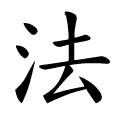法
- law, rule, method, principle;
Etymology
Originally written as 灋.
水 (water) – semantic, representing fairness, balance, and the flowing nature of justice.
廌 (haetae, mythical beast) – a creature of justice said to butt those who are unjust.
去 (to remove, drive away) – indicating removal of wrongdoers.
The original image depicts a person standing before water, judged by the haetae, symbolizing fair judgment and punishment.
Over time, the 廌 element was omitted, producing the modern simplified form 法.
Usage in Korean
법률 (法律) – law, legal code
방법 (方法) – method, way
헌법 (憲法) – constitution
불법 (不法) – illegal, unlawful
선거법 (選擧法) – election law
조리법 (調理法) – recipe, cooking method
Words that derived from 法
- 가법(家法)–family rules
- 대법원(大法院)–the Supreme Court
- 방법(方法)–way; means; manner
- 방법론(方法論)–method; methodology
- 법원(法院)–court of law
- 법칙(法則)–rule; law; regulation; principle
- 상속법(相續法)–law of succession; inheritance act
- 연역법(演繹法)–deductive method
- 용법(用法)–direction for use; instruction for use; usage; use of law
- 율법(律法)–commandments; religious precepts
- 합법(合法)–legitimacy; legality
- 화법(話法)–style of speech; rhetoric; speech; discourse
Additional notes
In early usage, 法 meant judgment and punishment under justice, rather than general “law.”
Classical Chinese distinctions: 律 (basic law, later criminal code), 令 (administrative law), 格 (supplementary statutes), 式 (regulations).
In Korean, the suffix “-법” often undergoes consonant fortition to [뻡], e.g. 선거법 [선거뻡]. Even 불법 is often pronounced [불뻡], a pronunciation now officially accepted.
In Chinese, 法 is also used as an abbreviation for France (法國, Fǎguó), derived from the transliteration 法蘭西. In Korean, however, “France” is usually abbreviated with 佛 (불) from 佛蘭西.
